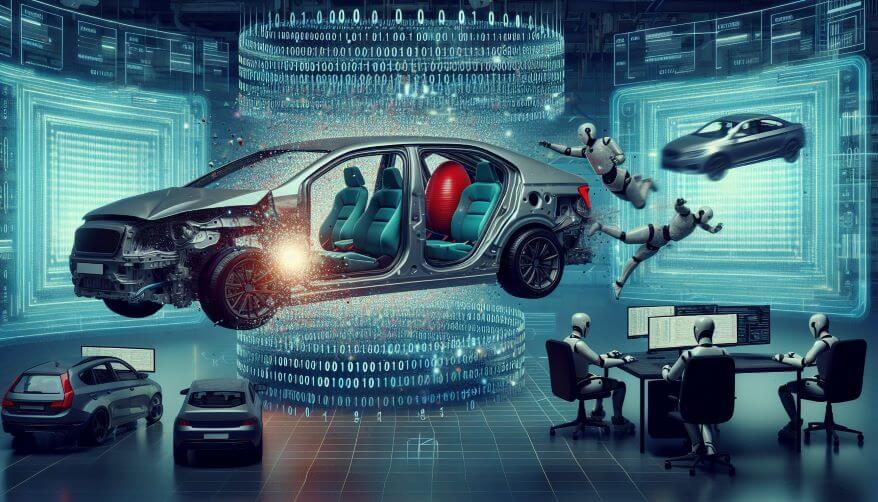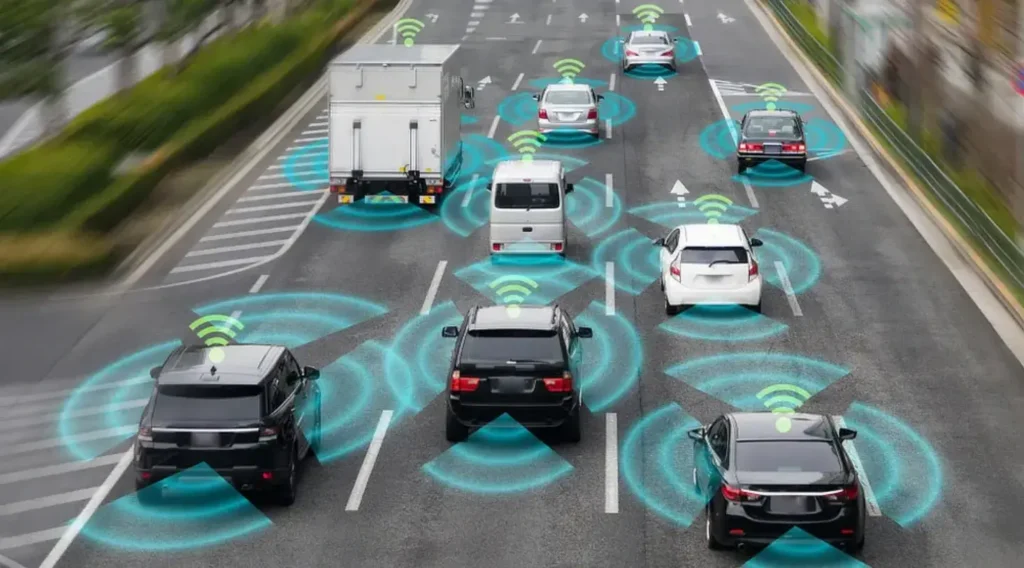The road to safer driving has taken a sharp turn—toward artificial intelligence. In 2025, cars aren’t just getting faster and more efficient—they’re getting smarter, learning to anticipate danger, assist drivers, and even prevent accidents before they happen.
From adaptive cruise control to pedestrian detection, AI is making cars safer than ever by enhancing vehicle intelligence across every system. This article explores the ways AI is revolutionizing automotive safety, saving lives, and transforming how we interact with vehicles.
Introduction: The Evolution of Automotive Safety
The concept of car safety has evolved dramatically—from mechanical seatbelts in the 1960s to airbags, anti-lock brakes, and electronic stability control. But now, we’ve entered a new era.
Today, AI-powered safety systems combine real-time sensing, machine learning, and automation to provide proactive protection. Unlike passive features, AI-based systems predict, analyze, and act—making decisions in milliseconds to avoid danger
The Role of AI in Modern Vehicle Safety Systems
AI enhances safety in three fundamental ways:
- Real-Time Data Processing: Vehicles collect data from cameras, LiDAR, radar, and ultrasonic sensors to understand surroundings instantly.
- Predictive Modeling: Machine learning identifies potential hazards based on patterns from millions of prior driving events.
- Autonomous Responses: AI systems can brake, steer, or alert the driver without human input in emergency scenarios.
By combining these abilities, cars in 2025 can analyze environments more accurately than humans ever could.
Advanced Driver Assistance Systems (ADAS)
AI is at the heart of modern ADAS—features that assist drivers in real time. These include:
- Lane Keeping Assist (LKA): Keeps the vehicle centered by monitoring lane markings.
- Adaptive Cruise Control (ACC): Adjusts speed based on traffic conditions.
- Automatic Emergency Braking (AEB): Detects imminent collisions and stops the car if the driver doesn’t react.
AI enables these systems to function seamlessly—even adapting to road conditions and driver behavior over time.
AI-Powered Collision Avoidance
Collision avoidance is one of the most critical safety enhancements in modern vehicles. AI helps prevent accidents through:
- Forward Collision Warning: Alerts the driver if a crash is likely.
- Blind Spot Detection: Uses radar and sensors to monitor adjacent lanes.
- Rear Cross-Traffic Alert: Detects approaching vehicles when reversing.
These features rely on sensor fusion, combining inputs from multiple data sources to build a complete picture of the surroundings.
Predictive Maintenance with AI
AI isn’t just about avoiding external dangers—it also prevents internal failures by analyzing vehicle health.
- Sensor-Based Monitoring: AI monitors wear and tear on tires, brakes, engines, and batteries.
- Failure Forecasting: Predicts when components are likely to fail, allowing preemptive repairs.
- Maintenance Scheduling: Suggests optimal service intervals based on driving patterns.
This reduces the risk of breakdowns or mechanical failures that can lead to accidents.
AI and Driver Monitoring Systems (DMS)
Driver error causes over 90% of road accidents. AI-based DMS aim to fix that by ensuring drivers stay alert and attentive.
- Drowsiness Detection: Cameras track blinking rate, head position, and facial expression.
- Distraction Alerts: AI detects phone use, eye movement, or hands off the wheel.
- Emotion Recognition: Some systems even sense frustration or aggression, adjusting alerts accordingly.
Brands like Volvo and BMW use AI DMS to warn drivers and even take control in emergencies.
Real-Time Road Condition Analysis
AI helps vehicles adjust based on real-world driving conditions, including:
- Weather Analysis: Rain, snow, and fog impact traction and visibility.
- Pothole Detection: Sensors identify road hazards and suggest alternate routes.
- Traffic Awareness: AI anticipates congestion and suggests rerouting.
This situational awareness improves decision-making and accident prevention.
AI in Autonomous Emergency Maneuvering
In critical moments, AI can perform life-saving maneuvers:
- Evasive Steering: Swerves the vehicle to avoid collisions if braking isn’t enough.
- Multi-Scenario Planning: Considers multiple escape paths and selects the safest option.
- Speed Modulation: Adjusts throttle and brakes in milliseconds.
This technology is already in use in Level 2 and Level 3 semi-autonomous systems from brands like Mercedes-Benz and Audi.
AI for Pedestrian and Cyclist Protection
Pedestrians and cyclists are especially vulnerable. AI helps by:
- Thermal Imaging & Night Vision: Detects humans in poor visibility conditions.
- Intent Prediction: Recognizes body language or motion that indicates crossing.
- Crosswalk Safety Systems: Preemptively alerts drivers and brakes if someone steps out.
These systems dramatically reduce urban accidents and fatalities.
Machine Learning in Crash Data Analysis
AI also learns from past crashes to improve future outcomes.
- Crash Pattern Recognition: Analyzes millions of collisions for root causes.
- Vehicle Model Optimization: Improves frame design, airbag deployment, and impact zones.
- Behavioral Data Feedback: Helps refine algorithms for better human-AI coordination.
This data-driven approach leads to continual improvements in vehicle safety software.
How AI Enhances Vehicle-to-Vehicle (V2V) Communication
AI is also central to the emerging field of vehicle-to-vehicle (V2V) communication. When cars talk to each other, they can anticipate events long before a human or even onboard sensors detect a threat.
🚗 Examples of V2V Use Cases:
- Collision Alerts: One car braking suddenly can signal others to slow down preemptively.
- Intersection Coordination: AVs coordinate movement to reduce crashes at four-way stops.
- Platooning: Vehicles drive closely together in formation, safely adjusting speed in sync.
AI processes this information in real-time to optimize safety and traffic flow, especially in smart city environments.
Case Studies: Automakers Leading AI Safety Innovation
Several manufacturers are integrating cutting-edge AI safety systems into their vehicles:
Tesla
- Uses AI to power Full Self-Driving (FSD) Beta with real-time vision-based object detection.
- Features include Autopilot, Smart Summon, and Navigate on Autopilot.
Volvo
- Known for prioritizing safety, Volvo uses AI for collision avoidance, pedestrian detection, and advanced driver monitoring.
- Piloting autonomous highway driving with NVIDIA DRIVE platform.
BMW
- Offers AI-powered parking assistance, lane change alerts, and emotion-sensitive driver feedback in its iX and 7 Series models.
Toyota
- Employs Guardian and Chauffeur platforms for parallel safety and autonomy.
- Uses AI to intervene when a driver is at risk of error.
Mercedes-Benz
- Offers Drive Pilot (Level 3) AI system in Germany, enabling hands-free driving under specific conditions.
AI Safety Standards and Regulations in 2025
With AI now deeply embedded in automotive systems, regulators have begun defining formal safety standards:
| Authority | Standard/Framework |
|---|---|
| NHTSA (USA) | AI performance benchmarks, ADAS safety ratings |
| Euro NCAP (EU) | AI-based testing criteria for emergency intervention |
| ISO/IEC 21448 (SOTIF) | “Safety of the Intended Functionality” for autonomous AI |
| UNECE WP.29 | Global AV cybersecurity and software update regulations |
These regulations aim to standardize how AI-driven safety systems are validated, deployed, and monitored globally.
Public Trust in AI Safety Features
Even with technological advancements, public trust remains essential. Drivers and passengers want to know:
- Is the AI system reliable?
- Can I override it in an emergency?
- How does it learn or update itself?
Manufacturers are addressing these concerns through:
- Clear documentation and transparency reports
- Driver education on ADAS limitations
- Fail-safe designs that allow human intervention
Building confidence in AI safety features will be key to widespread adoption.
Conclusion
Artificial intelligence is not just transforming cars—it’s transforming how we drive, protect, and navigate the road. By analyzing data faster than any human can, responding in real-time, and learning continuously, AI has made cars smarter—and significantly safer.
As technology continues to evolve, drivers can expect even more proactive protection, from predictive crash avoidance to fully autonomous emergency maneuvers. In 2025 and beyond, AI isn’t just a feature—it’s the foundation of a new era of automotive safety.


